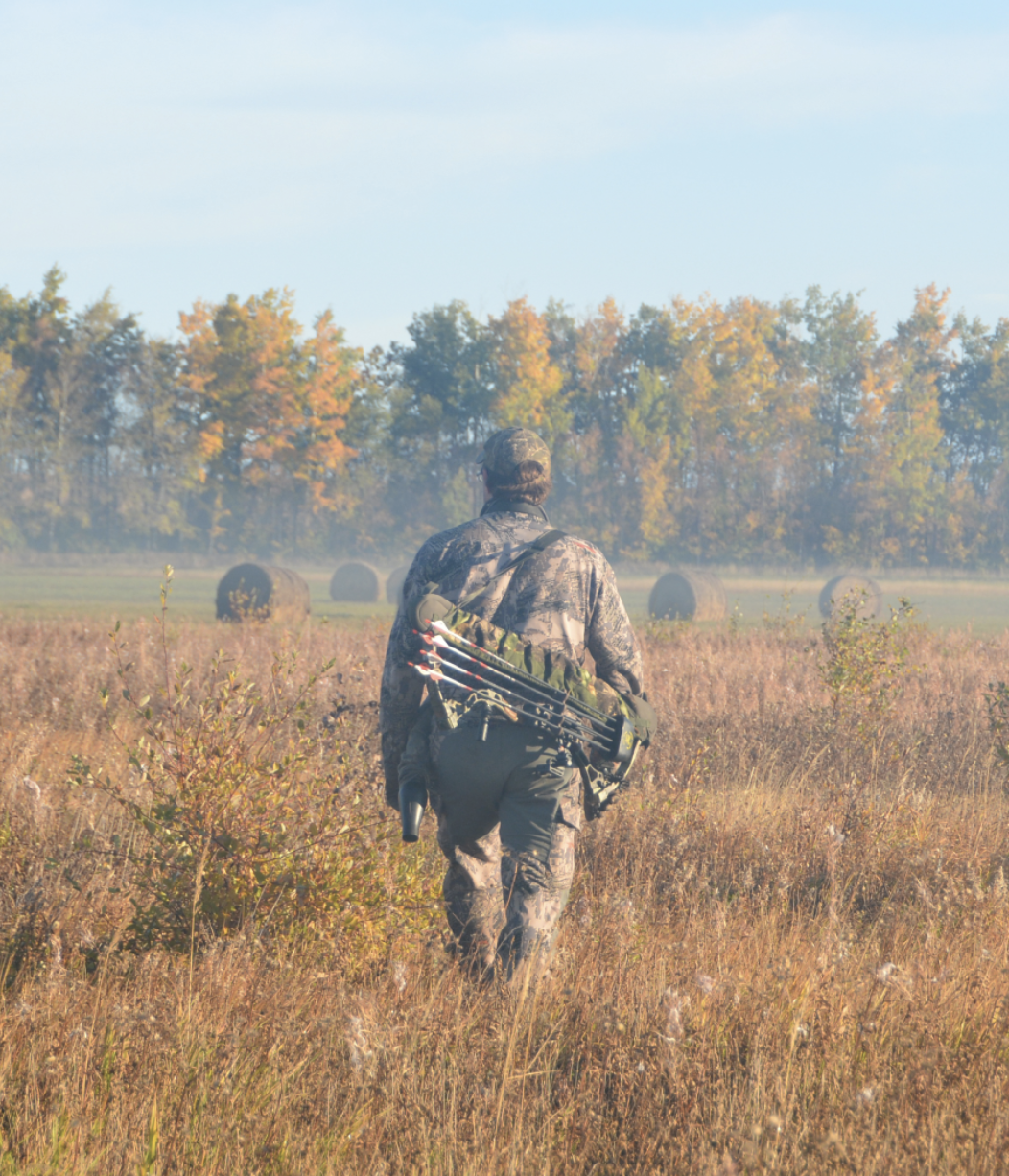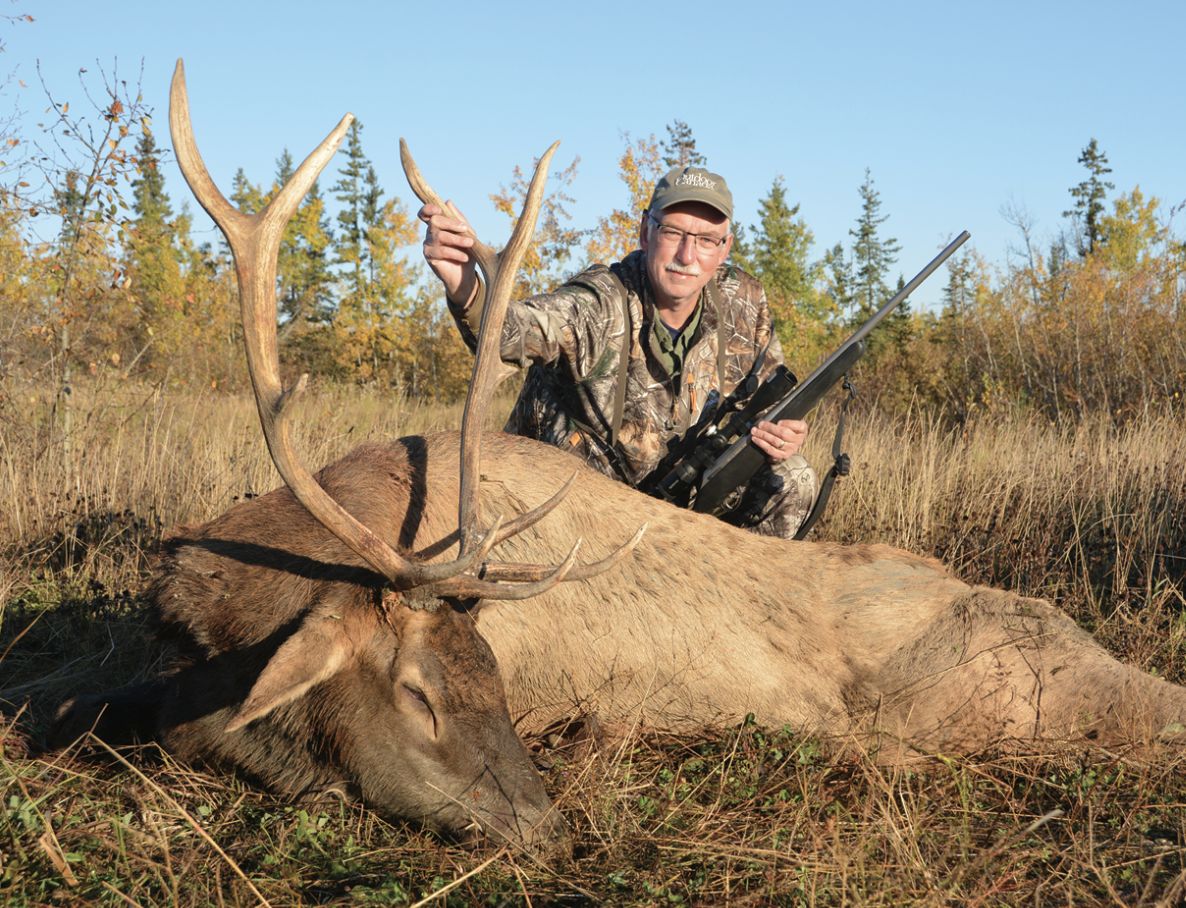
7 minute read
Back in the Saddle
► by Ken Bailey
Excerpted from his book, No Place Like Home: Fishing and Hunting Adventures Across Canada

I stand frozen, afraid to twitch, my eyes the only part of me moving. Less than 100 metres south is a bull elk; I could feel his last challenging whistle reverberate up my spine. North of me is another rut-stirred bull, having betrayed his location with an equally blood-curdling bugle; he’s even closer. Next to me, statuelike, is Logan Dolen, bow in hand. The elk are nearby and closing; it’s an exhilarating experience.
The forest goes deathly quiet, as if all of nature is holding its breath in anticipation, watching our game of chicken. Ultimately, we blink first, unable to withstand the suspense. We take just one step forward, in unison, and the immediate crashing of trees to our left makes us turn just in time to see the antlers of a mature bull storming away, 30 metres distant. Seconds later, as if choreographed, a similar thrashing erupts behind us; the other bull has also recognized our trap and departs furiously. Dolen and I look at one another, our faces betraying an odd mix of awe and disappointment, before breaking out in laughter. The jig is up—our impatience blew the opportunity. But in Alberta’s Saddle Hills County, we know more opportunity awaits.

To understand the outdoorsperson’s paradise that is Saddle Hills County requires you to step back 100 years to when the area was first settled. The Edmonton, Dunvegan and British Columbia Railway opened much of Alberta’s Peace River region for settlement, but upon its 1916 completion, the railway had ignored what is now Saddle Hills County. Partly as a result, today a mere 2,200 residents are spread across the county’s 5,800 square kilometres; the largest cluster, the hamlet of Woking, boasts a mere 100 residents.
By some measures the region never reached its potential. But if your vision of utopia includes vast tracts of native forests incised by cool rivers and creeks, with few people and limited industrial development, Saddle Hills County is paradise.
When I’d first hunted the Saddle Hills, 20 years previously, the abundance and diversity of big game left a deep impression. So when the opportunity arose to return to hunt rutting elk with outfitter Mike Ukrainetz, it was too appealing to ignore.
I arrived on a mid-September afternoon. The timing was perfect, with the elk fully in rut. I quickly got settled and by 6 p.m. was headed out with Dolen, a twenty-something guide whose family farms locally. From our first conversation it was clear he was a hunter through and through, with the focused mind of a predator.
Autumn everywhere at this latitude is resplendent in fall colours, but never more so than in the Peace River valley, a mesmerizing kaleidoscope of reds, yellows and oranges. So as we drove and got to know one another, my face was pressed to the glass—a little rude, perhaps, but forgivable, I hoped, given the natural distraction. Eventually we parked and prepared our gear. To the south was a heavily treed creek valley; to our north and east lay grain fields separated by fences and treelines. With a breeze from the southeast, conditions were ideal. We began walking the field edges, pausing occasionally to cow-call, hoping for a response from a randy bull in search of companionship. Periodically, we’d switch to a bugle, a no-holds-barred challenge to any bull willing to defend his harem from an intruder. After walking and intermittently calling for two kilometres, we sat in a 50-metre-wide finger of bush separating two fields, then began calling in earnest.
Bull elk in the Saddle Hills are generally not as large-antlered as those in the southern foothills. Here, a 300-inch bull is pretty good. But what they lack in antler size, they make up for in numbers; populations are healthy, thanks largely to the quality cover and plentiful feed. Each time you call, there’s a legitimate expectation of a response.
Elk have a way of materializing from the trees—one second a field is empty, the next there’s an elk standing there. In our case there were four elk—a cow, two calves and a bull. Even at 800 metres, the bull appeared worthy of closer inspection.
We made several attempts to entice him across the open field with a succession of cow-calls and the occasional bugle, but he was having none of it. His cow was prime for breeding and he wasn’t about to abandon her—a classic case of a bird in the hand.
We watched for 20 minutes before they lazily walked out of view. Immediately we began to scuttle to where we’d last seen them, hugging the treeline for cover. 30 minutes later we reached our target, a corner with forest to the south and east, open fields to the north and west. We glassed from the protection of cover and soon spotted them 400 metres to the north.
The shot angle and distance were more than I was comfortable with, so Dolen began to cow-call. The calves responded immediately, running directly towards our hiding spot. They closed to within 50 metres searching for the cow they were certain they’d heard, before wandering off, apparently losing interest.
For reasons we couldn’t explain—who knows what goes through the mind of an elk?—the bull then deserted his cow and followed the calves, closing to within 150 metres of our position. I couldn’t see him, but Dolen could, so he softly cow-called in hopes the bull would move into my line of sight. Instead, he stopped, clearly nervous.
I had no choice but to move or risk the anxious elk bailing. I edged slowly past Dolen until I could see the bull, now at 120 metres. I didn’t wait. My offhand shot took him through both shoulders and a second round brought the tough 5x5 down. It was 8 p.m.; I’d been hunting Saddle Hills County for all of an hour-and-a-half.

As we waited for reinforcements, Dolen and I began the task of fielddressing. At an estimated two-and-a-half years, the bull was in prime condition, fat and healthy; he’d be wonderful on the dinner plate.
By the time we’d finished prepping him, the crew from camp arrived. They were able to drive to where the bull had fallen, so loading him was as easy as it gets in elk country.
Back at camp we hung the bull to cool in the night air before retiring to the lodge. While I didn’t feel the least bit cheated, it occurred to me that my drive home would take four times as long as my hunt had lasted, so I wasn’t particularly keen to depart. Fortunately, I got my excuse to hang around a little longer when Dolen invited me to accompany him on a bowhunt the following morning.
So it was shortly after first light that Dolen and I found ourselves between those two bulls, each screaming their dominance while our calls teased them toward a confrontation. And even though it all went sideways, neither of us was particularly disappointed; mature bull elk at close quarters represents the very pinnacle of the big-game hunting experience. Besides, Dolen knew he’d have more opportunities before the season ended.
As for me? I can only hope that one day I’ll be back in the Saddle again.










